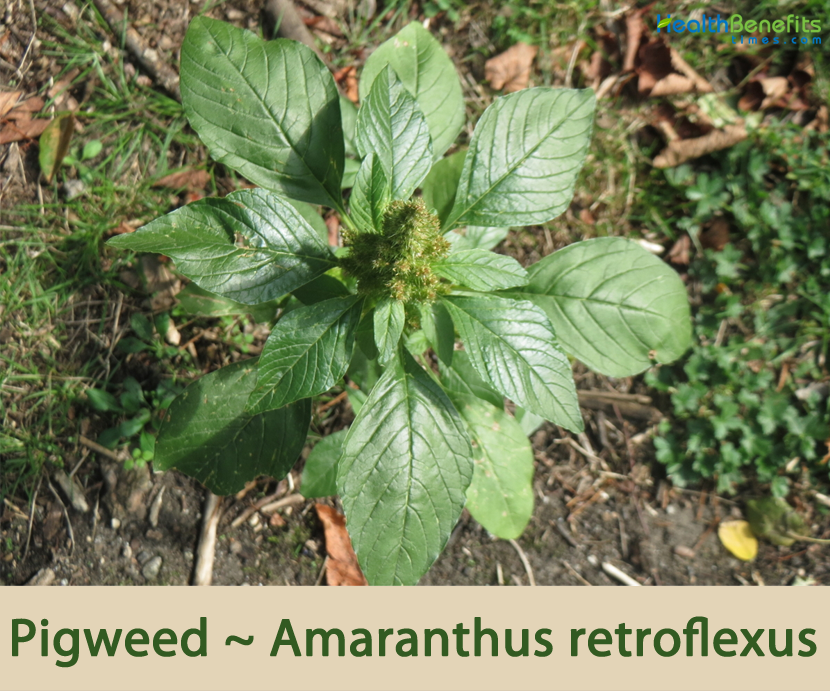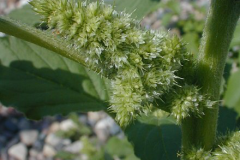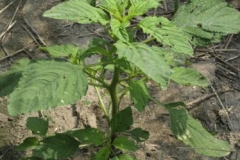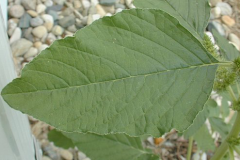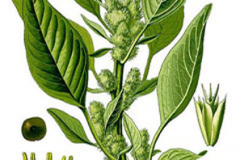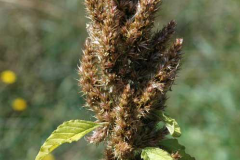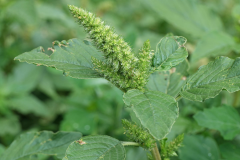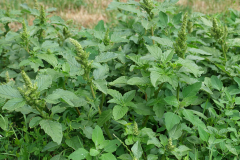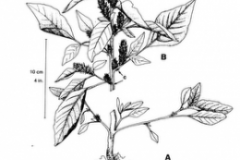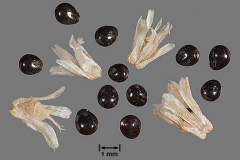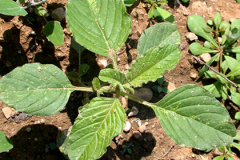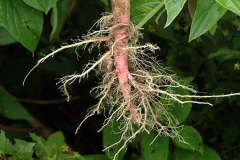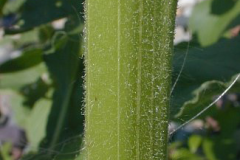| Pigweed Quick Facts | |
|---|---|
| Name: | Pigweed |
| Scientific Name: | Amaranthus retroflexus |
| Origin | Throughout North America, from Canada to Mexico, and from the Atlantic to the Pacific coasts |
| Shapes | Tiny, smooth or slightly rugose, broadly obovoid to broadly elliptic capsules, less than about 1/17 of an inch (1.5 mm) long |
| Taste | Sweet |
| Health benefits | Recover from Chronic Illness, Reduce Cholesterol Level,Remedy for Jaundice, Act as Antiseptic, Prevent Lung Infections, Improves Brain Health,Cures Dysentery and Diarrhea, Weight Controller, Prevent Common Summer Diseases, Good for Constipation |
| Name | Pigweed |
|---|---|
| Scientific Name | Amaranthus retroflexus |
| Native | Throughout North America, from Canada to Mexico, and from the Atlantic to the Pacific coasts. It is also found throughout much of the rest of the world, including Europe, South America, Eurasia, and Africa. It is a native of tropical America |
| Common Names | American pigweed, careless weed, common amaranth, pigweed redroot, redroot, redroot amaranth, redroot pigweed, reflexed amaranth, rough pigweed, wild-beet amaranth, Reflexed amaranth, Smooth Pigweed, Red-rooted amaranth |
| Name in Other Languages | Afrikaans: Misbredie Albanian: Pigweed, nena e përveshur, nenë Amharic: Pigweed-ˈpiɡwēd Arabic: Eshb alkhinzir (عشب الخنزير), Dillah (دلاه), Dillaq (دلاق) Aragonese: Bledo Argentina: Atac, ataco, caa-ruru, yuyo colorado Armenian: Khozuk (խոզուկ), havakatar haskavor (հավակատար հասկավոր) Azerbaijani: Pigweed, Geriqatlanan qaratərə Belarusian: Aksamitnik adkinuty (аксамітнік адкінуты) Bengali: Pigweed Bolivia: Ataco coman, chiori Brazil: Bredo, carura aspero, caruru Bulgarian: Shchyr (щир), obiknoven shtir (обикновен щир) Burmese: Kwmhkyaankone (ကွမ်းခြံကုန်း) Canada: Amarante a racine rouge Catalan: Marxant gros Chinese: Lí (藜), Fan zhi xian (反枝苋), Fǎn cì xiàn (反刺莧) Corsican: Amarantu Croatian: Stir, oštrodlakavi šćir, Rumenika Czech: Chřest, Laskavec ohnutý, laskavec srstnatý Danish: Opret amaranth, Opret amaranth, tilbagebjet anarant Dutch: Pigweed, Papegaaienkruid, Papegaaiekruid, English: Pigweed, American pigweed, Common Amaranth, Careless weed, Pigweed redroot, Red-root amaranth, Redroot, Redroot pigweed, Reflexed amaranth, Rough pigweed, Wild-beet amaranth, wild amaranth, slender pigweed, Common Tumble Weed Esperanto: Pigweed Estonian: Seavilla, Tähk-rebashein, tähkjas rebashein Filipino: Pigweed Finnish: Savikan, Vihreä revonhäntä French: Amarante, Amarante réfléchie, Brèche de Malabar, Épinard de Malabar, Épinard de Malabar, Amarante rouge, Amaranthe rétroflexe, Amarante à racines rouges, Amarante à tiges velues, amarante recourbee, blé rouge Galician: Bledo, bredo, Georgian: Pigweed German: Schweinekraut, Ackerfuchsschwanz, Bogen-Fuchsschwanz, Rau-Fuchsschwanz, Zurückgekrümmter Amarant, krummer Amarant, Zurückgekrümmter Fuchsschwanz, Gekruemmter Fuchsschwanz, Krummer Fuchsschwanz, Rauhhaariger Amarant, Rauhhaariger Fuchsschwanz, Zurückgekrümmter, zurückgebogener Amarant Greek: Chinopódio (χηνοπόδιο), Glintos, Trachy vlito, amárantos (αμάραντος) anakamptómenos (ανακαμπτόμενος), trachý vlíto (τραχύ βλήτο) Gujarati: Pigavīḍa (પિગવીડ) Hausa: Pigweed Hebrew: Yarbuz mufshal, חזיר, ירבוז מופשל Hindi: Pigweed Hungarian: Libatop, Szőrös disznóparéj Icelandic: Svínakjöt Indonesian: Pigweed Iran: Taj khoroos Irish: Muiceola Italian: Pigweed, Amaranto commune, Biedone, amaranto, blito Japanese: Butakusa (ブタクサ), Ao geitou (アオゲイトウ), aogeito (アオゲイト) Javanese: Pigde Kannada: Pigvīḍ (ಪಿಗ್ವೀಡ್) Kazakh: Pigvid (пигвид) Korean: Myeong-aju (명아주), Teol bi reum (털비름) Kurdish: Pigweed Lao: Mu (ໝູ) Latin: Pigweed Lithuanian: Kiaulė, Šiurkštusis burnotis Latvian: Liekt, Liektais amarants, liektā kaķaste Macedonian: Pigment (пигмент), Običen štir (Обичен штир) Madagascar: Amatarika Malagasy: Pigweed, Anampatsa, Anampatsamaitso, Anampatsamaitsovaventy Malay: Pigweed Malayalam: Pannippani (പന്നിപ്പനി) Maltese: Pigweed Marathi: Pigavēḍa (पिगवेड) Mongolian: Pigweed Navaho: Tłʼoh deeskʼidí Nepali: Pigweed Netherlands: Papegaaienkruid Norwegian: Pigweed, Duskamarant Occitan: Blets, caramùda, chiscle Oriya: ଘୁଷୁରୀ Ossetic: Dældzæhæra (Дæлдзæхæра) Pashto: سور لرونکی Persian: جگر, تاجخروس Peru: Yuyo Picard: Pasvélour Polish: Lebioda, Szarłat szorstki, Portuguese: Pigweed, Moncos-de-peru, Carurú-áspero, Caruru gigante, beldros, bredo Punjabi: Pigweed Romanian: Talpa-gâștei, ştir-sălbatic, ştir-verde, Stir Russian: Mari (марь), Shchiritsa obyknovennaya (Щирица обыкновенная), Shchiritsa zaprokinutaia (Щирица запрокинутая ), Amarant zaprokinutyi (Амарант запрокинутый) Serbian: Pigveed (пигвеед), obični stir, štir (штир) Sindhi: پگهار Sinhala: Pig රු මස් (pig ru mas) Slovak: Láskavec ohnutý Slovene: Navadni ščirovke Slovenian: Pigweed, Srhkodlakavi ščir Spanish: Alga marina, Amarant, Amaranto, Amaranto común, Atacu, Atreu, Bledo, Blet, Blet punxent, Breo, Hierba meona, Marxant, moco de pavo, penacho, quelite, yuyo, bledo rojo, quentonil, Abrebujo, Acederón, Atreu del Perú, Jascas Sudanese: Pigweed Swedish: Svinamarant Tajik: Pigweed Tamil: Paṉṟi iṟaicci (பன்றி இறைச்சி) Telugu: Pigweed Thai: Pigweed Turkish: Horoz ibiği, Kıımızı köklü tilki kuyruğu, Kırmızı köklü horoz ibiği , Yabani pazı, horoz kuyruga Ukrainian: Kosichka (косичка), shchyrytsya zahnuta (щириця загнута) Upper Sorbian: Prosty šćěrjenc Urdu: Pigweed Uzbek: Pigweed, Eshakshoʻra Venezuela: Pira Vietnamese: Heo con Welsh: Pigweed, Blodau Amor, Blodyn Amor, Chwyn Moch Yugoslavia (Serbia and Montenegro): Hrapavi stir Zulu: Ingulube |
| Plant Growth Habit | Monoecious, erect, finely hairy, freely-branching, herbaceous annual plant |
| Growing Climates | Common in cultivated fields, gardens, fence rows, waste places, orchards, fallow land, stream valleys, pastures, prairie ravines, vineyards, railroads, roadsides, vacant lots, old homesteads and backyard gardens, river banks, and other open, disturbed habitats where annual weeds predominate |
| Soil | Poor growth on gravel, dense clay, and sodic-saline soils; fair growth on sandy, clay-loam, organic acidic, and saline soils; and good growth on sandy loam, loam, and clay. Optimum soil depth was 10 to 20 inches (25-50 cm) |
| Plant Size | Near 3 m (9.8 ft) |
| Root | Taproot pink or red, depth varies with soil profile |
| Stem | Stem stout, subterete to angled, densely furnished with multicellular hairs |
| Leaf | Leaves are numerous; alternate, 1 to 6 inches long, ½ to 3 inches wide on leaf stalks that are 2/5 to 3 inches (1–8 cm) long. Leaves are egg to diamond-shaped, widest at or below the middle, hairless to sparsely hairy, more densely hairy along the veins on the underside |
| Flowering season | July to September |
| Flower | Tiny flowers are tightly packed in small clusters (glomerules) in a spike-like arrangement at the tips of branching stems and arising from leaf axils, with a few to several flowers in a glomerule. The spikes are thick, dense, relatively short, erect to ascending but not stiff, and usually numerous. Flowers are either male or female, both on the same plant (monoecious) and usually mixed within the same glomerule. |
| Fruit Shape & Size | Tiny, smooth or slightly rugose, broadly obovoid to broadly elliptic capsules, less than about 1/17 of an inch (1.5 mm) long |
| Seed | Seed oval to egg-shaped, somewhat flattened, notched at the narrow end, 1 to 1.2 mm long, shiny black or dark red-brown. |
| Propagation | By seed |
| Taste | Sweet |
| Plant Parts Used | Leaves and seeds |
| Season | August to October |
| Health Benefits |
|
Plant Description
Pigweed is a monoecious, erect, finely hairy, freely-branching, herbaceous annual plant that normally grows near 3 m (9.8 ft.) tall, although it can be often found 2 ft. tall. The plant is common in cultivated fields, gardens, fence rows, waste places, orchards, fallow land, stream valleys, pastures, prairie ravines, vineyards, railroads, roadsides, vacant lots, old homesteads and backyard gardens, river banks, and other open, disturbed habitats where annual weeds predominate. The plant has poor growth on gravel, dense clay, and sodic-saline soils; fair growth on sandy, clay-loam, organic acidic and saline soils; and good growth on sandy loam, loam, and clay. Optimum soil depth was 10 to 20 inches (25-50 cm). Its invasiveness causes yield loss in many vegetable row crops. It grows unbranched or with minimal branches.
Stem
Stems are few-branched to many-branched, moderately to densely hairy particularly in the upper plant, green to red to striped green/red, and have a pink to reddish taproot, which is the source of the common name. They are 10 cm – 2 m high, but usually 50 – 90 cm, simple or branched, lower part thick and smooth, upper part usually rough with dense short hair. Plants are typically erect but when subject to mowing can be low and more sprawling, the branches spreading from the base and rising near the tips (decumbent).
Leaves
Leaves are numerous; alternate, 1 to 6 inches long, ½ to 3 inches wide on leaf stalks that are 2/5 to 3 inches (1–8 cm) long. Leaves are egg to diamond-shaped, widest at or below the middle, hairless to sparsely hairy, more densely hairy along the veins on the underside. They are dull green above but lighter green and with prominent whitish veins below. They are bluntly pointed at the tip, wedge-shaped to somewhat rounded at the base, on a hairy stalk half to about as long as the blade. Edges are toothless and often somewhat wavy.
Flower
Tiny flowers are tightly packed in small clusters (glomerules) in a spike-like arrangement at the tips of branching stems and arising from leaf axils, with a few to several flowers in a glomerule. The spikes are thick, dense, relatively short, erect to ascending but not stiff, and usually numerous. Flowers are either male or female, both on the same plant (monoecious) and usually mixed within the same glomerule.
Both male and female flowers have 5 tepals that are 2.5 to 3.5 mm (to 1/8 inch) long, thin, translucent whitish with a green midrib, more or less oblong and rounded at the tip, with a minute, sharp point at the apex (mucronate). Male flowers have 3 to 5 yellow stamens, female have a 3-parted style at the tip of an oval green ovary and are shorter than to about as long as the tepals. At the base of each flower is a bract that is longer than the tepals, green, tapering to a pointed tip, with a midrib that extends to a pale, spine-like tip. Flowering occurs from June through November.
Fruit
Fertile flowers are followed by tiny, smooth or slightly rugose, broadly obovoid to broadly elliptic capsules, less than about 1/17 of an inch (1.5 mm) long. Fruit open around the middle by a cap like lid to release one seed each.
Seed
Seed is elliptic to obovate in outline, somewhat compressed with an obtuse marginal rim, cross-section elliptic to lens-shaped or barely fusiform, with a protruding notch along the margin where hilum occurs and from which a shallow depression runs inward for a short distance, 0.9–1.3 mm diameter and 0.6–1 mm thick. Surface is shiny and smooth, dark reddish-brown to black colored.
Health benefits of Pigweed
Pigweed leaves and seeds aren’t only delicious, but they’re also nutritious. They’re rich in vitamins A and C as well as other important minerals, such as iron, manganese, calcium, zinc, copper, and magnesium. Adding pigweed into your daily diet can improve your health and immunity immensely. A nutritionist has explained exciting health benefits of pigweed which are listed below
1. Good for Constipation
Pigweed helps to eliminate the constipation problem. Mostly the older and children are suffering from the constipation problem nowadays. Gravy prepared from pigweed acts as a laxative and improves overall health.
2. Prevent Common Summer Diseases
Pigweed is considered best to consume during the summer season. If we take pigweed gravy with cold water rice during the summer season, it will cure body heat, dysuria, prickly heat, coup rap. Pigweed also acts as a medicine for the top 5 summer diseases like chickenpox, herpes, jaundice, typhoid and measles commonly found near villages. Extract of pigweed applied to prickly heat will reduce the inflammation and make it cool and dry. The village people believe that a paste prepared using pigweed applied on herpes boils will make it cool and dry and cures the condition of the disease.
3. Weight Controller
For underweight children, pigweed with capsicum and onion included in their diet will increase their body weight. If we cook pigweed as soup with garlic, tomato, cumin, pepper, it will reduce the overweight and makes you thin. Because the pigweed is less in calorie it can be taken as a complete food for a meal.
4. Cures Dysentery and Diarrhea
For dysentery and diarrhea, the seeds of pigweed smashed in tender coconut water will act as good medicine.
5. Improves Brain Health
To improve your brain health, drink a cup of equally mixed pigweed extract with Bhringraj extract. Pigweed consists of omega 3 fatty acids and it helps in brain development. It also prevents you from the symptoms of ADHD.
6. Prevent Lung Infections
Pigweed consists of a large amount of vitamin A, C, and vitamin B complex. It prevents you from lung infections. It acts as one of the medicines to cure mouth cancer.
7. Act as Antiseptic
Growing pigweed at home is equal to keeping a first aid box. Pigweed cures on fire burns, scabies just wash the complete plant grind it and apply it to the infected area this acts as an antiseptic cream.
8. Remedy for Jaundice
Complete pigweed plant ground with tender coconut water or buttermilk and make it as a ball and mix it with cold rice water and drink it every morning before breakfast this cures jaundice, scouring and leucorrhea.
9. Reduce Cholesterol Level
Cook the pigweed with garlic and include in your diet that will reduce the level of cholesterol in your blood. Also, your body will get cool, if you include frequently pigweed in the diet.
10. Recover from Chronic Illness
Pigweed is beneficial from children to old age people; it purifies the blood and help to recover the body from chronic illness. It increases milk production in breastfeeding mothers.
Traditional uses and benefits of Pigweed
- Tea made from the leaves is astringent.
- It is used in the treatment of profuse menstruation, intestinal bleeding, diarrhea etc.
- An infusion has been used to treat hoarseness.
- Consuming pigweed can help alleviate fever, headache, nausea, stomachache, and other digestive disorders.
- Tea made from these leaves can help treat sore throat, heavy menstrual bleeding, diarrhea, internal bleeding, and internal ulcers.
- You can also use the tea topically to treat cuts, rashes, scrapes, and insect bites.
- It is used as a poultice to relieve inflamed sores.
- In bathrooms it is used to calm the fever.
- It has been used in infusion to treat aphonia.
- The bledo helps regulate intestinal transit.
Culinary Uses
- Seeds are eaten raw or cooked.
- They can be ground into a powder and used as a cereal substitute.
- It can also can be sprouted and added to salads.
- Young leaves have a mild flavor and can be eaten raw or cooked as spinach.
- It is eaten in Mexican markets as Quelite quintonil.
- It is often added to maize meal.
- Seed can be cooked whole, and becomes very gelatinous like this, but it is rather difficult to crush all of the small seeds in the mouth and thus some of the seed will pass right through the digestive system without being assimilated.
- The young shoots and leaves can be eaten raw.
- It is used in the Indian state of Kerala to prepare a popular dish known as thoran by combining the finely cut leaves with grated coconut, chili peppers, garlic, turmeric and other ingredients.
- The seeds can be ground into flour and used for bread, hot cereal, or as a thickener.
- Fresh young plants can also be used as a potherb.
- In northern Iran leaves of redroot pigweed are eaten in soups.
Other Facts
- Yellow and green dyes can be obtained from the whole plant.
- Like many other species of Amaranthus, this plant may be harmful and even deadly when fed to cattle and pigs in large quantities for several days.
- However, when supplied in moderation, it is regarded as an exceptionally nutritious fodder.
- It is a good companion for potatoes, onions, corn, tomatoes, peppers and aborigines.
- One plant can produce up to 100.000 seed per season.
- Seed is able to germinate even after 40 years of dormancy.
- Name “pigweed” refers to the fact that this plant usually grows on the pastures where pigs are fed.
Precaution
- Avoid use during pregnancy.
- Pigweed is rich in oxalic acid. Sometimes it may cause as oxalate salt and retain in the kidney. So, people who are suffering from kidney malfunctioning can avoid this green.
- People sensitive to oxalic acid should also not eat it in abundance for long periods. Its high oxalate content can cause fatal nephrotoxicity.
- If its consumption causes swelling, it may be a reflection of high nitrate content. This is especially noticeable if the plant comes from land fertilized with chemical fertilizers.
Prevention and Control
Due to the variable regulations around (de)registration of pesticides, your national list of registered pesticides or relevant authority should be consulted to determine which products are legally allowed for use in your country when considering chemical control. Pesticides should always be used in a lawful manner, consistent with the product’s label.
Control
Cultural Control
Seedlings can be controlled by cultivation, but older plants often recover from mechanical damage and produce axillary inflorescences. Soil solarization under plastic can provide control of A. retroflexus if high temperatures are achieved for prolonged periods of time.
Chemical Control
A. retroflexus is readily controlled by most herbicides which inhibit photosynthesis, such as atrazine, simazine, metribuzin, linuron and bromoxynil. It is also highly susceptible to the synthetic auxin herbicides, such as 2, 4-D or dicamba, and sulfonylurea and imidizolinone herbicides, such as imazethapyr, thifensulfuron-methyl, rimsulfuron and nicosulfuron. Most other herbicides for control of broad-leaved weeds also provide good control including acifluorfen, fomesafen and pendimethalin. Its pattern of intermittent germination throughout the growing season, however, makes the application of residual soil-applied herbicides, or sequential post-emergence treatments, necessary in heavily infested fields. A. retroflexus can be controlled by the soil fumigant methyl iodide.
Herbicide Resistance
Populations of A. retroflexus resistant to atrazine have been reported in the USA, Canada, France, Germany, Hungary, Switzerland, Spain, Poland, Chile and the Czech Republic. Many of these are cross-resistant to metribuzin and linuron. Populations resistant to ALS inhibitors (sulfonylureas and imadizolinones) have been reported in the USA and Israel. In the past 20 years biotypes resistant to 15 herbicide active ingredients have been reported in 15 countries.
Biological Control
Biological control of A. retroflexus with fungal pathogens has been reported. The pigweed flea beetle, Disonycha glabrata, is native to the southern USA and South America. It has been promoted as a control agent of A. retroflexus, but it gives incomplete control in the field because beetle populations develop too slowly and too early in the season to prevent competition with the crop and seed production.
References:
https://www.itis.gov/servlet/SingleRpt/SingleRpt?search_topic=TSN&search_value=20745#null
http://www.hear.org/pier/species/amaranthus_retroflexus.htm
https://npgsweb.ars-grin.gov/gringlobal/taxon/taxonomydetail?id=2803
https://pfaf.org/user/Plant.aspx?LatinName=Amaranthus+retroflexus
https://www.cabi.org/isc/datasheet/4652#todescription
http://www.theplantlist.org/tpl1.1/record/kew-2633061
https://www.fs.fed.us/database/feis/plants/forb/amaret/all.html
https://gobotany.nativeplanttrust.org/species/amaranthus/retroflexus/
https://en.wikipedia.org/wiki/Amaranthus_retroflexus
http://www.flowersofindia.net/catalog/slides/Redroot%20Pigweed.html
https://powo.science.kew.org/taxon/urn:lsid:ipni.org:names:10698-2
https://plants.sc.egov.usda.gov/home/plantProfile?symbol=AMRE


